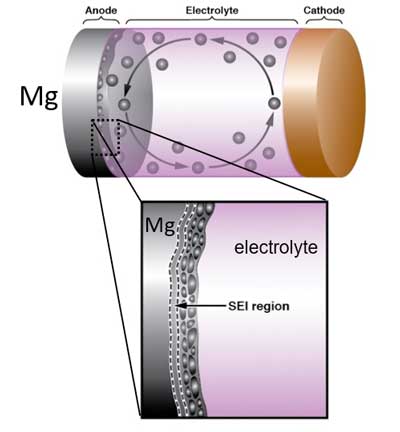| Oct 31, 2019 | |
Nanocrystals help magnesium batteries go on-the-move(Nanowerk News) Researchers recently studied rechargeable batteries at the Center for Functional Nanomaterials (CFN). The CFN is a Department of Energy Office of Science user facility. The batteries had anodes (the positively charged side of a battery) made of magnesium (Mg) metal. |
|
| Scientists used scanning transmission electron microscopy (STEM), which can take images of extremely small objects, to measure the batteries as they operated. | |
| The study (ACS Applied Energy Materials, "Achieving High Cycling Rates via In Situ Generation of Active Nanocomposite Metal Anodes") revealed a combination of nanometer-scale features that were key to improving the battery’s performance. In particular, they found it was important for extremely tiny crystals of Mg to form on the anode as the battery worked. | |
 |
|
| Schematic of a rechargeable battery with magnesium (Mg) anode. (Bottom) Close-up of the Mg anode/electrolyte interface, showing the solid electrolyte interphase and formation of Mg nanocrystals during battery operation. (Image: Brookhaven National Lab) | |
| Magnesium anodes can store five times as much energy in the same space as graphite anodes. Commercial lithium-ion batteries currently use graphite anodes. Magnesium anodes also have a unique operating mechanism. This mechanism enables batteries to charge and discharge quickly at freezing temperatures (0 °C). This characteristic is important for using these types of batteries in cars and other transportation applications. | |
| The morphological control of electrochemically deposited metallic anodes, such as Li, Zn, and Mg, under high applied rates is essential for the development of high-energy-density batteries. For transportation applications, maximizing high rates and high energy density is key to attaining viable customer acceleration and range expectations, respectively. | |
| In this work, the in-situ generation of Mg nanocrystals allowed cycling under high rates (10 mA cm–2) and reduced temperature (0 °C) for the very first time. Through operando STEM analysis, we discovered a highly functional solid electrolyte interphase (SEI), a first of its kind, which enabled continuous deposition and dissolution of Mg without internal shorting. | |
| The unique morphology of the deposited Mg and the functional capability of the SEI are key to future development of practical metallic Mg anodes. |
| Source: Brookhaven National Laboratory | |
|
Subscribe to a free copy of one of our daily Nanowerk Newsletter Email Digests with a compilation of all of the day's news. |
